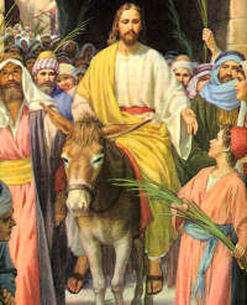Background of Palm SundayPalm Sunday is the Sunday before Easter – the sixth and last Sunday of Lent. It marks the beginning of Holy Week, the week of events leading up to Jesus' death. Palm Sunday commemorates the triumphal entry of Jesus into Jerusalem to celebrate the Passover. The gospels record the arrival of Jesus riding into the city on a donkey, while the crowds spread their cloaks and palm branches on the street and shouted "Hosanna to the Son of David" and "Blessed is he who comes in the name of the Lord" to honor him as their long-awaited Messiah and King! Palm Sunday is an occasion for reflecting on the final week of Jesus' life. It is a time for Christians to prepare their hearts for the agony of His Passion and the joy of His Resurrection (ShareFaith, 2012). All four Gospels retell of the account of Jesus' entry into Jerusalem- Matthew 21:1-11 (Year A), Mark 11:1-11 (Year B), Luke 19:28-39 (Year C) and John 12:12-19. The story begins with Jesus sending two of his disciples into the village to collect a colt and bring it to him (Mt 21:6-7, Mk 11:4, Lk 19:32, John 12:12-19). The Disciples did as Jesus had said and before they brought it to him, they lay their cloaks on the colt. In both Matthew (21:8) and Mark (11:8) scripture illustrates how people spread their cloaks and laid branches along the ground as a path for Jesus. Luke (19:36) mentions people spreading their cloaks but does not make mention of branches of any sort. The Gospel of John is the only reading that mentions branches of Palm trees (John 12:13). The Gospels speak of how excited the people were to see Jesus (Mt 21:9-10, Mk 11:9-10, Lk 19:36-38 and John 12:13, 12:19). In John (12:19) the text identifies that the Pharisees could see the impact of Jesus’ entry into Jerusalem by stating, “You see, you can do nothing. Look, the world has gone after him!” |
Background of symbols, actions and objects associated with Palm SundayThe first Palm Sunday story signifies the fulfilment of the prophecy found in Zechariah 9:9- the Anointed One who has come to redeem us from our sins and break the power of death. The following symbols represent significant meaning and purpose to the message Jesus was trying to convey to Gods people (Darst-Williams, 2012).
Today, the Catholic church celebrates Palm Sunday by the blessing of 'Palm branches' through prayer. This blessing is done prior to the High Mass on Palm Sunday. Vested in red cope and standing at the Epistle side of the Altar, the priest recites a short prayer, and then reads a lesson from the book of Exodus which tells of the children of Israel coming to Elim on their way to the Promised Land, where they found a fountain and seventy palm trees (Fish Eaters, 2012). Following the priest reads the story of Christ's triumphal entry into Jerusalem the Sunday before His death, and about how the people put palms in the Savior's path and sang hosannas. Then they pray, begging God that they may in the end go meet Christ, that they may enter with Him into the eternal Jerusalem. Then follows preface and prayers asking God to bless the palms, that they may be sanctified and may be a means of grace and divine protection to those who carry them and treasure them with faith (Fish Eaters, 2012). The palms are saved in many churches to be burned the following year as the source of ashes used in Ash Wednesday services. The Catholic Church considers the blessed palms to be sacramentals. The vestments for the day are deep scarlet red, the color of blood, indicating the supreme redemptive sacrifice Christ was entering the city to fulfill his Passion and Resurrection in Jerusalem (Fish Eaters, 2012). |
Photo used under Creative Commons from D.Eickhoff

